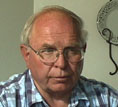|
Steve Monsen Livestock’s Role in Spreading Weeds and Pinion-Juniper Steve Monsen was born into a family that had raised livestock in Sanpete County, Utah, since the 1850s. And he might have continued in his family’s profession had his father not persuaded him to attend college. Mr. Monsen then went on to earn a BS degree in botany and range science from Brigham Young University, where he also pursued graduate study. He began his career with the Utah Fish and Game Department before joining the USDA Forest Service’s Intermountain Research Station (later renamed the Rocky Mountain Research Station) at Provo, Utah, where he participated in many rangeland restoration projects. Mr. Monsen received the Outstanding Achievement Award of the Society for Range Management in 1991. He retired from the Forest Service in 2002.
Steve Monsen explains how overgrazing by cattle and sheep throughout the Great Basin,
beginning in the mid-19th century and continuing to the present day, has initiated a cascade of environmental changes that have disrupted vegetational communities and extremified their fire regimes, resulting in the replacement of native vegetation with weeds that are noxious, toxic, or nutritionally deficient for wildlife as well as livestock.
Not mentioned by Monsen, though, is that in addition to the harm introduced just by overgrazing, livestock further accelerate the spread of weeds by inadvertantly transporting their seeds. See Belsky and Galbard’s article for those details. Recorded in August 2004. Read the edited transcript of Steve Monsen’s entire interview. |
